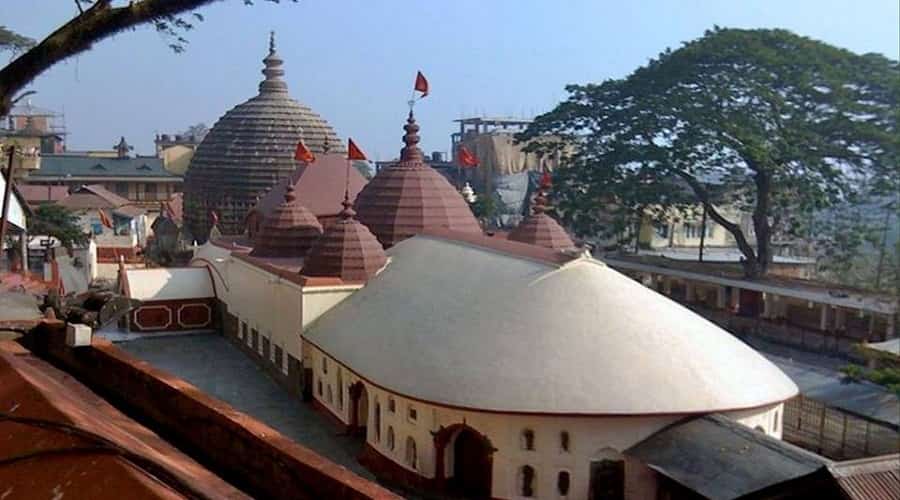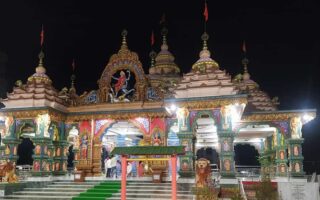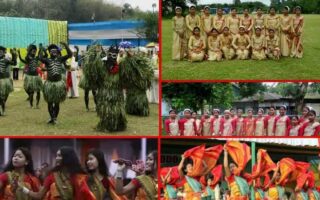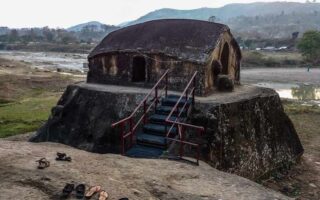Kamakhya Temple is located high uphill known as Kamagiri or Neelachal Parbat in Guwahati is one of its numerous pious landmarks that speaks volume regarding the affluent past fortune over which Assam is placed. This sanctified temple placed in the centre point of the state holds a significant approach in the eyes of the devotees. This temple was constructed in respect to Goddess Sati or Kamakhya who is believed to be 1 of the manifestation of Goddess Sati or Goddess Durga.

The place of worship is located a few kms from the Railway station of Guwahati and is thronged by devotees all around the year. (King Nara Narayana)of Cooch Behar had constructed this place of worship in the year 1665.The place of worship comprises of 7 oval spires each peaked by 3 golden colored pitchers ,also the entry coiled downward to a curved trail of a few distance that specially connects to the Kamakhya Temple. A number of sculpted boards of the place of worship bear portrayal of Goddesses and Gods related to the Hindu Religion engraved in an enchanting pattern. You will spot many Pigeons, Tortoises and Monkeys loitering in the premises of the temple as the temple is meant to be their dwelling place. The enigmatic and nonviolent atmosphere of the place of worship coalesces together to appease the mind of the devotees and take to journey of internal salvation.
With the complete picturesque locale and enigmatic splendor, Kamakhya Temple, truly is 1 of the outstanding structures, not only famous in the state of Assam, but all across the country.
The other temples in the complex are devoted to the varied forms of mother goddess including Bhuvaneshvari, Bagalamukhi, Chinnamasta, Tripura Sundari and Tara. In addition, the complex also holds many smaller shrines devoted to Kala Bhairava, Lord Shiva and other Hindu deities.
Legend
As per the legend, this is spot where the female genitalia, uterus, of Sati fell when Lord Vishnu dissected her mortal body to compel grief-stricken Lord Shiva to come out of the pain and perform his celestial duties.
It so happened that King Daksha, Sati’s father, had kept a sacrificial ritual for which he called all the deities. However, he intentionally did not call Lord Shiva so that he would feel insulted. Enraged on this, Sati came to the occasional place even though she was not invited. On the ceremony, Daksha started abusing Lord Shiva, which became unbearable to Sati and she drew herself in the sacred fire to mark the presence of Shiva in the ceremony. On this, Lord Shiva’s meditation became unstable and in a destroyal mood, he reached to this place where he demolished everything.
Inconsolable Lord Shiva started performing the dance of devastation (Tandav) holding the mortal body of his dearly loved wife on his shoulders at that place. Seeing this, Lord Vishnu sent his chakra (Divine Wheel) to split the body into pieces in order to pacify Shiva and prevent the destruction of the world. It is believed that parts of the body of Sati fell on different places on Earth among which the site of the temple is the place of her reproductive organ, the yoni. All these places are generically named as Shakti Peethas.
When the Sati’s yoni fell on the location of the temple, the hill became blue in color that gives it its name as Nilachal. Originally, Kamdev, the God of Love, with the help of the celestial designer Vishwakarma, founded this peetha and built the temple. The temple was named so by the demon king, Narakasur who made the goddess as the patron deity. The shrine has a series of steps downwards to a mysterious chamber wherein the matra yoni is covered with a silk sari and flowers.
History
This sacred site is first traced in the Allahabad inscriptions of the Emperor Samudragupta. As per the legend, the Goddess herself prohibited the Koch Bihar royal family to perform puja at the temple. Even today, due to fear, none of the descendants even looks at the temple’s hill. Since then, the temple witnessed bad times without proper benefactor. Later in 1658, the Ahoms under King Jayadhwaj Singh took interest in renovating the temple. Even after Ahom kings, the following decades gave all support to the temple through devout Shaivite or Shakta.
From 1696 to 1714, Rudra Singh ruled the area and he decided to become a true Hindu by living the rest of his life under a Guru, spiritual preacher who would teach him mantras. In his keen desire to hug the religion in its true sense, he came across a Brahmin. However, he could bear the thought to succumb to him and show humbleness to a Brahmin. Still keen to have a Guru, he ordered his representative to go to Bengal to bring Krishnaram Bhattacharyya who was a renowned Mahant of the Shakta cult in Malipota near Santipur in Nadia district.
Initially, the Mahant did not want to come. However, upon promising to give the Kamakhya temple to him for taking its care, the Mahant became ready to come. Repeating the history again, the king still did not accept him as a Guru. In turn, the king did not let his journey go in waste and asked his sons and the Brahmins to accept him as their spiritual Guru and contended the Mahant.
After the death of Rudra Singh, his eldest son Siba Singha who took over his father’s rule from 1714 to 1744 delegated the responsibility of the Kamakhya temple and large portion of the Debottar land to the Mahant. Since then, the Mahant and his heirs dwelled on the Nilachal Hill and due to this; they were called Parbatiya Gosains. Today, several Kamakhya priests and contemporary Saktas of Assam belong to this group related as either followers or successors.
Temple – At a Glance
The original form demolished by Kala Pahar being unknown, the current temple dares back to 1565 that was reconstructed by Chilarai of the Koch dynasty by giving a touch of medieval style. The temple is adorned with a beehive-shaped seven oval spires with three golden pitchers, attractive panels, and images of gods and goddesses in the exterior, the most attractive being that of Lord Ganesha, the son of Shiva and Parvati (rebirth of Sati) and the God of wisdom and prosperity.
Festivals
Famous for Tantra worship, many tantra devotees attend the annual festival of Ambuvaci. The Manasha Puja is another stunning annual celebration. Further, during the festival of Navratri in September/October, Durga Puja is celebrated for five days in the temple in autumn that pulls thousands of devotees around the globe.
Tourists’ Attractions around Kamakhya
Kachapukhurib
This site refers to a natural pond holding countless turtles on the hill. The striking phenomenon here is the occupancy of these amphibians at such a great height. This really puts the zoologists and other people in a dilemma.
Other Temples
These include the Bhutanese Tara Temple; shrine of the snake Goddess, Manasa; and the Bhubaneswari Temple at the peak located near Kamakhya. The Bhubaneswari Temple provides a fantastic view of Guwahati and the Brahmaputra River.
Reaching the Temple
By Air
The nearest airport is Gopinath Bordoloi Airport at Borjhar located at a distance of 14 km from the city.
By Rail
Guwahati is the nearest railway station at a distance of 8 km. from the temple.
By Road
The Kamakhya temple is connected to the city via a good road. Further, Guwahati is well linked with the other major cities of the country such as Calcutta and Delhi by road, air, and rails.



Kamakhya temple is the most beautiful and spiritual place to visit. Thanks and subscribed your blog for updates.